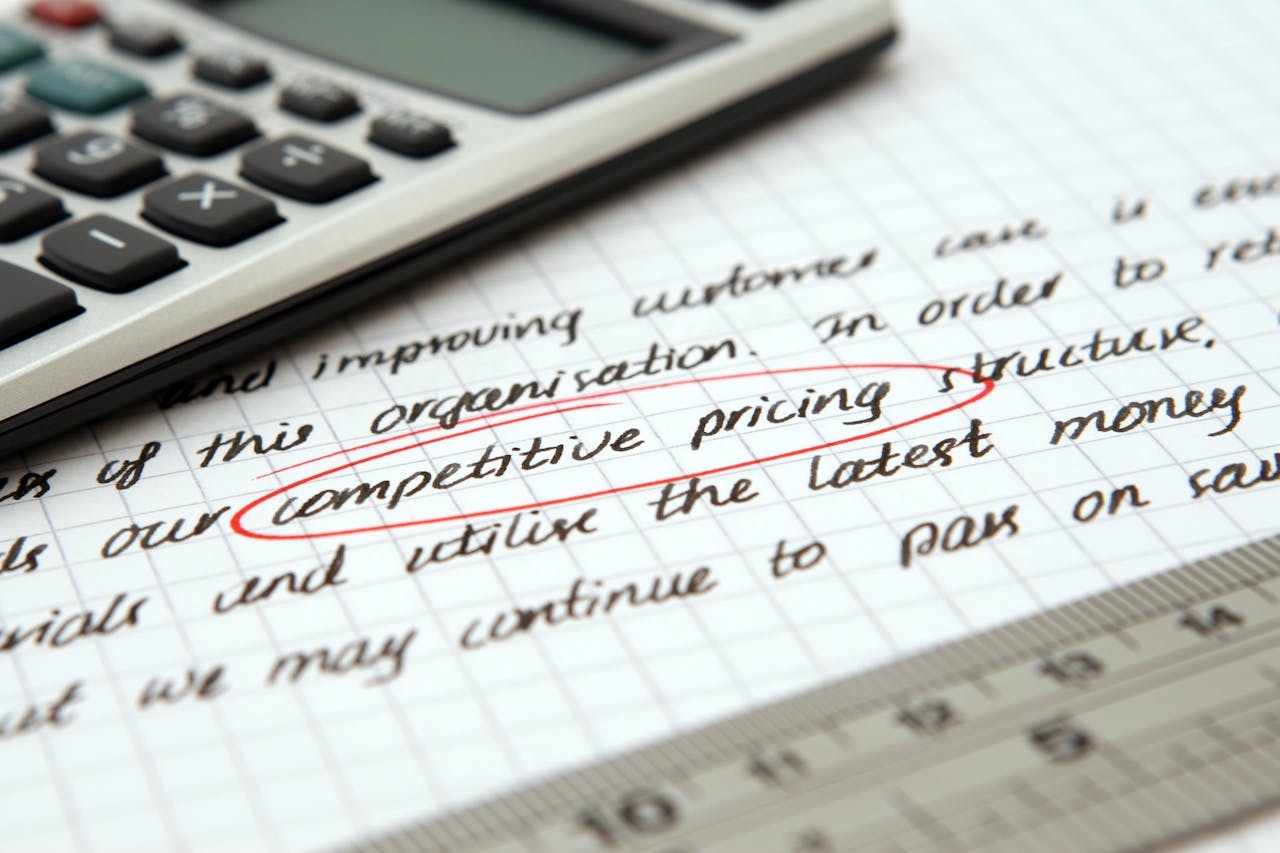Smart Pricing Strategies: How to Price a Product for Maximum Profit
By Anttoni Taimela · 26. February 2024
Finding the sweet spot when deciding how to price a product is key to thriving in a competitive marketplace.
This guide cuts through the complexity, offering clear, actionable steps to unpack the art of pricing.
Without revealing all just yet, anticipate learning about assessing costs, analyzing competitors, and tapping into customer psychology.
Our focus is on how to price a product to bolster profits🤑 and consumer appeal, covering various strategies without overwhelming you with excess detail.
Key Takeaways
- Pricing isn’t just picking a number; it’s an intricate dance involving costs, market trends, competition, and consumer pulse. Get it right, and your business struts; get it wrong, and it stumbles.
- Understand your COGS and keep an eagle eye on those flirtatious variable costs and the ever-so-steady fixed costs—knowing them is as crucial as a chef knowing their spices.
- Mix and match pricing strategies like you’re concocting a spell; value-based for the perception potion, cost-plus for a simple charm, competitor-based for a sneak attack, and dynamic for a bit of market magic.
Understanding Product Pricing
 price of products
price of products
Product pricing🏷️ has a significant influence on business aspects like cash flow, profit margins, and customer demand.
It essentially serves as the heartbeat of the business, driving its performance and success. It’s like a master puppeteer, controlling the strings of your business success.
But the question is, how do you determine the right selling price?.
Pricing a product is more than just picking a number. It involves a blend of pricing methods, considering factors like costs, competition, and customer needs.
It’s about setting a price that is a win-win for both you and your customers.
Before you set a price, it’s crucial to consider how you stack up against competitors, ride the waves of consumer trends, and juggle different pricing strategies.
Importance of Pricing
Mastering the pricing process is vital for business success, as it affects profitability, customer perception, and market positioning.
Think of price as your silent salesman – it speaks volumes about your product even before your customers interact with it.
But why consider market demand when setting prices? Well, it ensures that a product is priced just right, keeping businesses in the game and on top of their game in the market.
And when deciding the level of mark-up for product pricing, it’s crucial to take a good look at market research and ensure that the chosen strategy helps us reach our desired level of profitability.
Factors Influencing Pricing
A variety of subtle factors influence pricing decisions, operating behind the scenes. Costs, competition, customer whims, and those ever-shifting market trends all have a say in the matter.
It’s like being in a constant tug of war, and only the businesses that balance these forces effectively can win the pricing game.
Ever wondered how your competitors and market trends affect your pricing?
Businesses need to keep an eye on what their rivals are charging and the general market rates, figure out what customers are willing to shell out, and also take into account the special status of cutting-edge products that can give them the power to set the market prices. But wait, there’s more.
There are pricing strategies like target costing and cost-plus pricing that you need to consider.
And then there are price maximization strategies that are all about playing the game of ‘What the market will bear,’ where you charge the highest possible price the market can handle.
Calculating Costs for Product Pricing
 product pricing
product pricing
Understanding the costs associated with your product is a prerequisite before venturing into the realm of pricing strategies.
It’s sort of like knowing the ingredients needed for your secret sauce. You’ve got to have a handle on your fixed costs – those recurring expenses that just won’t quit, even if you sell a ton of products.
And then there are variable costs, those that change with the level of activity such as the number of units produced.
Ever heard of COGS? It stands for the cost of goods sold, which is the cost of each unit of a product.
This little metric is crucial for making sure that the selling price of a product is set just right to cover the cost of producing the goods and contribute to the gross profit margin.
So, how do you crunch these numbers to figure out the break-even cost per unit and net profit margin?
Well, it’s all about factoring in both overhead and fixed costs to ensure your profits surpass these expenditures.
Fixed Costs
Fixed costs are like those recurring expenses that just won’t quit, even if you sell a ton of products. Examples include:
- Rent
- Salaries
- Utilities
- Insurance
- Loan repayments
- Business license taxes
It’s absolutely vital to factor in fixed costs when setting a product’s price to make sure all those pesky recurring expenses are taken care of.
How do you calculate these fixed costs? Well, you start by adding up all the production costs, then do some fancy math with the variable costs and the number of units produced to finally uncover the fixed expenses.
It’s like solving a mystery to uncover the true costs of your business.
Variable Costs
Variable costs are the chameleons of expenses – they change with production volume. Think supplies, materials, and packaging. In the manufacturing world, they cover:
- costs of goods sold (COGS)
- raw materials
- packaging
- wages and commissions
- some utilities, which are different from overhead costs.
To figure out your variable costs, you start by figuring out the unit variable cost and then multiplying it by the total quantity of output.
It’s crucial to factor in these costs when setting your prices to ensure you’re not caught off guard by these fluctuating expenses.
Popular Pricing Strategies
 pricing
pricing
Having understood the costs, we can now explore various pricing strategies. It’s like exploring different flavors of ice cream – each one unique and appealing in its own way. We’ve got all the hits:
- value-based pricing
- cost-plus pricing
- competitor-based pricing
- dynamic pricing
The cost-plus pricing strategy is all about sprinkling a dash of desired profit margin on top of the production costs to conjure up the price of a product.
But is cost-plus pricing really the only game in town when it comes to setting product prices?
Absolutely not! Businesses like to keep their options open and consider other pricing techniques before settling on a final price.
Value-Based Pricing
Value-based pricing is all about pricing products based on how much people think they’re worth. It’s like a game of perception.
For instance, you could charge a premium for a product if it’s the only one available in a specific spot or if it’s designed by a famous name.
And when it comes to showcasing product options, nothing beats the 3-tier option with those nifty tick boxes for product features and benefits.
It’s the gold standard for value-based pricing.
And how about handling discounts? In value-based pricing, the key is to tactfully inquire of customers, ‘Which aspect of value are you willing to sacrifice for a lower price?’.
It’s all about crafting the final price by assigning a monetary value to each recognized customer benefit.
Cost-Plus Pricing
Cost-plus pricing is basically the art of slapping on a desired profit margin to production costs.
To calculate the product selling price using this strategy, you simply take the cost and then add a profit margin, which is just a percentage of the cost price.
The golden rule for the markup percentage in cost-plus pricing is a solid 25%. But remember, cost-plus pricing is just one of the players in the game.
Businesses like to keep their options open and consider other pricing techniques before settling on a final price for their products.
Competitor-Based Pricing
Competitor-based pricing is like using your competitors’ prices as a cheat sheet. So, how can a savvy company snoop on its rivals’ pricing strategies?
By conducting a competitive pricing analysis. This involves putting together a thorough comparison of market prices for similar products, keeping a close eye on those prices, and spotting any trends.
Dynamic Pricing
Dynamic pricing offers several benefits for both businesses and customers, including:
- Customized prices based on individual preferences and demographics
- Increased revenue for businesses
- Improved customer satisfaction
- Avoidance of stock shortages
- Competitive prices for customers
- Price changes based on demand
- Finding deals that suit their budget
So, how do you implement dynamic pricing? Here are some steps to follow:
- Get inside the minds of your buyers
- Find that perfect value metric
- Add a dash of time-based auction pricing
- Sprinkle some coupons and discounts on top
Companies use fancy machine learning algorithms to figure out who gets what price based on things like where they live and other nifty factors.
Finding the Right Pricing Strategy for Your Business
 pricing
pricing
Discovering the suitable pricing strategy for your business can be compared to finding an ideal pair of shoes.
It needs to fit perfectly, be comfortable, and match your style. This involves analyzing market research and balancing profitability with customer satisfaction, all while considering the right pricing model.
The target market has quite the influence on the choice of pricing strategy. Their needs and characteristics, along with the competition’s market shares, really call the shots.
And the juggle of making money and keeping customers happy? It’s all about understanding your customers inside out and making sure they see the value in what you’re offering.
Analyzing Market Research
Market research is the compass that guides your pricing decisions. It helps businesses figure out what their customers are willing to shell out. It involves using various methods, such as:
- The Van Westendrop Price Sensitivity Meter
- Gabor-Granger technique
- Conjoint analysis
- Cost-plus pricing
- BPTO (Brand price trade off)
In your market research, you should gather up:
- Customer demographics
- Geographic locations
- Buying habits
- Preferences
- Reliable data from different sources
Snooping on competitors’ pricing data can add some flavor to your pricing strategy by giving you the upper hand with lower prices.
Balancing Profitability and Customer Satisfaction
Achieving a balance between maximizing profits and ensuring customer satisfaction is the hallmark of a successful pricing strategy.
It’s like being a tightrope walker, where one wrong move can lead to a fall.
The crucial factor is to ensure that your pricing contributes to building a sustainable business.
You do this by setting a selling price that factors in a nice little markup on top of the total product costs.
And remember, keeping your existing customers happy is way cheaper than chasing after new ones.
When customers think a product or service is worth more, it gives businesses the green light to charge more or sell more, ultimately boosting profits.
Tools and Techniques for Accurate Pricing

Businesses can enhance the pricing process by utilizing high-quality software and tools such as product pricing calculators.
These can help businesses nail down the perfect price that keeps both their customers and their profits happy.
And if you’re looking for the hip options, check out RevOps, Symson, and Craftybase. But what about Excel?
Excel is like a wizard’s wand for businesses, offering the power to organize, manipulate, and analyze hefty data sets for accurate pricing.
Using Excel for Pricing Calculations
Excel can work its number-crunching wizardry by offering an array of functions and features that streamline the process and ensure precision.
To calculate the product selling price using Excel, just use the selling price formula =A2/(1-B2), where A2 represents the cost and B2 represents the margin percentage.
By using Excel, companies can effortlessly summarize customer revenue by product and unleash complex calculation methods to craft well-informed pricing strategies.
Product Pricing Calculators
A product pricing calculator is a fancy tool that does all the math to figure out how much to charge for a product.
For instance, Shopify’s profit margin calculator crunches the numbers by adding a percentage markup to the total costs of making a product to figure out the final selling price.
The gross margin in the example provided by Shopify’s profit margin calculator is a solid 20%.
But remember, product pricing calculators are only as good as the info you feed them. The juicier the details, the juicier the results.
Quick Tips for Effective Product Pricing
Before concluding, let’s quickly review some tips for effective product pricing. First, make sure to crunch the numbers on total product costs and then add a little extra for that sweet selling price.
And don’t forget to calculate the average selling price by dividing the total revenue by the number of units sold.
To ensure accuracy, it’s important to calculate selling price with precision.
Second, guarantee your profit margins are on point by setting a selling price that factors in a nice little markup on top of the total product costs.
And finally, always ensure that your pricing strategy is flexible enough to keep up with the ever-changing market conditions, customer demands, and competitive landscapes.
Adapting Your Pricing Strategy Over Time
Similar to fashion trends, your pricing strategy should evolve over time. It’s crucial for staying competitive and addressing changing market conditions, customer preferences, and business objectives.
Indicators that a business should revise its pricing strategy include:
- Increased costs without price adjustments
- Declining sales
- Low profit margins
- Increased competition
- Changes in customer preferences
And when the market demand decides to throw a curveball, it can mess with your pricing strategy by messing with your revenue, forcing you to adjust prices.
Summary
Well, we’ve had quite a journey, haven’t we? We’ve explored the fascinating world of pricing strategies, delved into the importance of understanding product pricing, dissected fixed and variable costs, and studied popular pricing strategies such as value-based, cost-plus, competitor-based, and dynamic pricing.
We’ve also learned about the importance of analyzing market research, balancing profitability with customer satisfaction, and using tools and techniques for accurate pricing.
Remember, pricing is not a one-time decision but a constant process of adaptation. Stay flexible, keep an eye on the market, understand your costs, and most importantly, know your customers.
After all, a well-crafted pricing strategy is a surefire way to maximize profits, attract and retain customers, and secure a competitive market position. So go ahead, put these tips into action, and watch your business thrive!
Frequently Asked Questions
How do you calculate the price of a product?
To calculate the price of a product, start with finding the base production cost and then add your desired profit margin to establish the product price. It’s simple, just add it up!
What is selling price formula?
To calculate the selling price, follow this formula: SP = CP + Profit Margin, where CP is the cost price. Simply add the profit margin to the cost price to get the final selling price. Easy, right?
What is by-product pricing?
By-product pricing is a savvy strategy where a manufacturer capitalizes on the value of a secondary product to offset some expenses or even lower the cost of the main product. It’s a win-win situation!
What is the importance of product pricing in a business?
Product pricing is essential for a business because it directly impacts profitability, customer perception, and market positioning. It affects various aspects like cash flow, profit margins, and customer demand for your products.
What are some popular pricing strategies?
When setting prices, consider value-based, cost-plus, competitor-based, and dynamic pricing strategies to find the best fit for your business. Avoid confusion to your customers by using a clear and consistent pricing strategy.

